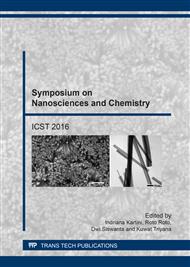p.135
p.142
p.149
p.154
p.160
p.166
p.173
p.182
p.190
Toxicity Test of Chromium and Glutaraldehyde to Determine Greener Chemical in Tannery Industry
Abstract:
The aim of this study was to investigate the toxicity level of chromium and glutaraldehyde. This research was conducted by testing the resistance level of fungi (Aspergillus niger sp.) toward glutaraldehyde and chromium in the medium of Potato Dextrose Agar (PDA). Variable of this experiment was the growth of Aspergillus niger sp. that indicates the resistance level of Aspergillus niger sp. The growth rate of Aspergillus niger sp. was classified on four scales. They were, (I) scale 1: zero growth; (II) scale 2: low growth (+); (III) scale 3: medium growth (++); (IV) Scale: 4 high growth (+++). All collected data were analysed by One Way ANOVA. The result showed that the toxicity of chromium and glutaraldehyde tanning material were highly significantly different toward Aspergillus niger (P<0,01). The Aspergillus niger sp. growth rate scale in chromium medium was high (scale 4: 4.00±0.00). Meanwhile, the growth rate scale of the Aspergillus niger sp. in glutaraldehyde medium was low (scale 2: 1.33 ± 0.58). Based on the fungi growth rate, it can be concluded that glutaraldehyde was more toxic than chromium tanning material toward Aspergillus niger sp. Furthermore, it can be said that glutaraldehyde is not quite ideal to be used as an alternative of chromium as a tanning material.
Info:
Periodical:
Pages:
160-165
Citation:
Online since:
July 2017
Authors:
Keywords:
Price:
Сopyright:
© 2017 Trans Tech Publications Ltd. All Rights Reserved
Share:
Citation:


